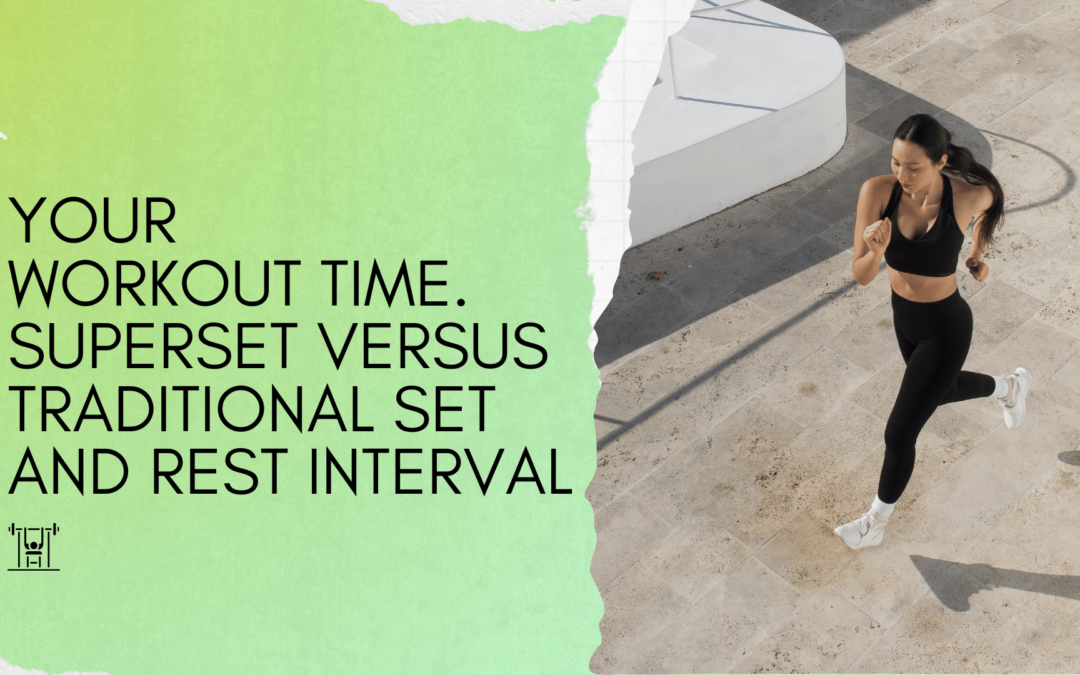
Strength By Fitness
Let us talk about your workout time as we compare doing super sets versus a traditional resistance training workout.
Welcome to another fact-based article from Strength by Fitness.
First thing first, I am going to be talking about this study in this article, and not only will I discuss the particulars of this specific study, but I will also provide you with an alternative way to make the best out of the study findings and conclusion so that you can shape a better routine for your life puzzle.
No matter if you are constrained for time and need to go with the time-saving approach for your gym life, or if you have the available time to make your workouts and progression even better by doubling your workout volume and the total sessions you do per week and muscle group without increasing your normal gym time.
Cut your workout time in half or get more volume and sessions per week and muscle group without increasing per session time in the gym.
In our busy bee world, it is not an unusual feeling to feel deprived of time, right? Even the most ardent time keepers amongst us who live life well organized, timely, and with a solid understanding of stress management, and healthy fit priorities will at the very least, at times experience that uncanny sensation that there just isn’t enough time in their day-to-day life to properly do, and enjoy every important, and enjoyable thing they would like to cram into their schedule.
All the while, on the other end of the spectrum, most people aren’t even good at prioritizing the important things in their life, big pillars such as their health, nutrition, sleep, and fitness.
Or their relationship for that matter.
Now, to add to that complicated, and unhealthy modern-day life puzzle where most humans work too much, stress too frequently, never disconnect from work emails and social media stress, binge watches too many shows and movies on Max and Prime video, while they eat nothing but poorly made takeaway food that isn’t remotely close to being as nutritiously healthy as it should be, and well, things aren’t that swell with homo sapiens in the year of 2024.
This is why so many of our sedentary earthlings have developed this eerie point of view, that they just don’t have time to exercise.
A conclusion that only serves to make things even worse.
Health outcomes spiral downward in our sedentary world, and age-and-sedentary-related diseases are increasing in scope and severity.
Further, a lack of proper enough and frequent enough fitness, and physical activity only makes the consequences of a bad life puzzle even worse.
A lack of regular exercise makes people sleep even worse, and it makes the sad health impact of chronic stress even worse.
Anxiety, depression, and dementia, not to mention cancer, cardiovascular disease, obesity, diabetes, and metabolic syndrome are all the same. The risk of getting them, and the severity if you do, all get much worse when people do not hit the gym well enough, and frequently enough.
So what can we do?

Well, just say hello to the agonist-antagonist superset that has come to the rescue.
One thing you could do, if you would like to exercise more frequently but remain steadfast in your belief that you just don’t have enough time to do a meaningful workout is to implement the agonist-antagonist super set.
This is how I train myself, and I have been doing it like this pretty much every workout for the last 10+ years. Not that you have to use a superset, but because when I compare my workouts these days, with the traditional way I spent my first 20 years in the gym I have lost no strength, or muscle mass progression at all.
To be frank, I have gained even better athletic capacity and continued to gain strength, and muscle mass despite already being advanced in my fitness years, and this is despite the fact that I am not 20 years old anymore.
Nor am I using steroids.
In other words, the agonist-antagonist superset makes a lot of sense. Not just based on my personal experience, but based on up-to-date, contemporary data. However, as I said, you can do the traditional way of doing 1 set per exercise, followed by a rest-set interval. If that is what feels the best for you, that is perfectly fine.
It worked for hundreds of millions of people, and it will continue to work for many more.
The only downsides are either substantially longer workouts per session, to meet the same volume per workout and week, as well as the need for more gym visits to keep the same sessions per week & muscle group.
So the agonist-antagonist super set, is it all nothing but big wins, or can we find anything negative about it? And what is it?
The agonist-antagonist super set simply means that you take two exercises that activate opposing muscle groups and you do one real set in both exercises, the second one following directly after your set in the first exercise.
Once both sets have been done you proceed to take your set-rest-interval.
A pretty simple change to be honest. The downside is, of course, that it is slightly more challenging for your body. At least if you train with any kind of effort and intention of becoming fitter.
The plus side with this is that you become a better athlete. Muscular endurance & cardiovascular health improve slightly more. And the way I do it myself, and program it for our clients has never hurt my own, or our client’s strength, muscle mass, and progression, or per exercise and session effort either.
If anything I see myself, and our clients outwork pretty much anyone on a consistent weekly basis.

It needs to be discussed, the compound exercise caveat.
It needs to be said however, that strength and per-session effort, and progression over time will take a slight hit in some exercises. Especially when some of your exercises are made up of bigger compound exercises like rows, deadlifts, and squats and especially so when the effort and load is high.
The above caveat really only applies, however, if you do not program your agonist-antagonist super set in a proper way.
What I mean by this is that most people seem to make use of the agonist-antagonist super set to save per session, workout time.
In other words, they do both exercises swiftly, with very little rest in between the agonist and antagonist exercise, which is proper.
Following the completion of one set in both exercises, they then rest for a shorter amount of time, perhaps only 60 to 120 seconds before they repeat it and do the next superset.
This is perfectly fine, mind you.
Even better, it is a wonderful way to get a lot of effort and exercise volume into a shorter amount of time. But doing the super set like this will reduce the pace of your strength progression a little bit, as this study will demonstrate too.
In order to save total workout time you neither add more volume, nor do you rest as long between each superset.
This setup, the time-saving super set also requires you to not add additional exercise volume compared to your regular gym session.
In other words, you simply take your normal workout selection, and you use the same amount of sets, reps, and exercise selection.
The two differences are that you do two exercises together in one super set, and rest for a shorter period of time in between each super set.
The thinking behind this is simple.
By using agonist-antagonist exercises, such as the dumbbell flat bench press and the bent-over dumbbell row you train your chest, triceps, and shoulders with the first exercise, this doesn’t require much effort from your posterior chain, namely your lower, middle or upper back and posterior delts.
Nor are you challenging your biceps much to speak of.
So right after you finish your last dumbbell chest press repetition, you stand up, breathe in for 5 to 30 seconds or so, and continue with the bent-over dumbbell row.
Yes, this exercise can really challenge your cardiovascular system as well as your entire back, biceps, and posterior shoulders if you go for a big load and RIR 0, and you should challenge yourself with a heavier load and you should go for a proper RIR 0 to 3 set.
Our back is a very large muscle group, and a very resilient and strong muscle group. So the key not only to develop it, but to keep it injury resilient throughout your lifespan is to train it with bigger loads and a big effort on a weekly basis. You just have to use proper technique with a good lengthened stretch under load phase, but I have talked about that previously, so let us leave that part of the puzzle outside of this article.
Now, while you are doing your bent over dumbbell row your chest muscles, and side, and anterior shoulders and your triceps are resting. Sure, all the muscles mentioned in these two exercises act as each other antagonists so there is still muscle activation in your chest when you do a dumbbell row.
But its not happening at a level that fatigues your antagonist muscle group, for all intent and purposes the antagonist muscles are very much recovering while the agonist is working their ass off.
In other words, once you finish your row, you already have a minute or two of good solid recovery going on in the agonist muscles that worked hard during your first set.
Coach Mike
Strength By Fitness
In other words, once you finish your row, you already have a minute or two of good solid recovery going on in the agonist muscles that worked hard during your first set.
This means that it is now time to rest up properly, because this is your real set-rest-interval.
So stretch a bit, drink water, and rest everything for 60 to 120 seconds and you are almost fully rested. This comes to the surprise of some, because this line of thinking holds up very well in real life and scientific studies, and the resulting progression in strength, power and lean muscle mass is still going to be really good.
The progression is not identical, however. Especially not in strength when effort and load are high enough. Its a bit less compared to the traditional way of doing one set in one exercise in isolation.
But it is close in general, and as I said, you will spend a lot less time in the gym. It also has some minor upsides in the case of better athletic capacity and muscular endurance.
This is in other words a really good way of achieving an almost optimal hypertrophy and strength, power progression, while saving plenty of time.
What about the compound caveat?
The caveat that is called compound exercises is simply this.
The bigger the exercise, the bigger the load, and effort the more the human body will have to recover before you can do yourself justice and deliver another set on the same performance level ( or better ).
So doing a squat + something else will be much more challenging for your body than a biceps curl + lateral raise super set.
This is called the stimulus to fatigue ratio, or SFR in short.
Now, some people misinterpet this and take it as a clear downside of doing big compound lifts. Claiming that big effort compound lifts exhaust you too much compared to what you can achieve in the isolated muscle if you had chosen to use strict, isolation exercises instead.
Or, as the opposing enthusiasts like to say, this clearly mean that smaller, isolated exercises provide to little global capacity progression for real athletic capacity, since they do not activate enough of your body globally speaking, or even provide a meaningful stimulation of the intended muscle chain.
But this is not the proper takeaway either way you look at it.
We have to balance the stimulus we get relative to the fatigue it creates and put that in comparison with our capacity for recovery, as well as consider why we train, what is the intended purpose of our workouts and what is the progression goals over time that we are actually looking for.
Coach Mike
Strength By Fitness
We have to balance the stimulus we get relative to the fatigue it creates and put that in comparison with our capacity for recovery, as well as consider why we train, what is the intended purpose of our workouts and what is the progression goals over time that we are actually looking for.
When we do this in a proper fact-based way we realise quite soon that big effort, big compound lifts, isolated exercises, machines and free weight stuff all serve a needed place in a proper fact-based fitness plan.
Becuase all these exercise variations allows us to maximize our health and fitness progression while balancing our capacity for recovery. As a further bonus the combination of all these exercise variations allows us to craft the perfect progression of our athletic capacity.
Now, with all this said. If you do not feel the need to save workout time because you have no problem fitting 90 minutes or 120 or even 2.5 hours of gym time into your life, then I have even better news for you. Because you can in that case make use of the agonist-antagonist super set to cram even more muscle activation and workout volume into each gym session and gym week without increasing your current gym time.
If you are wondering how you can turn it upside down and increase the volume but not your gym time, this is where my method of doing the agonist-antagonist superset comes into play.
You see, I am not doing it to save time. I am making use of the agonist-antagonist superset to cram more high-quality exercise volume, and sessions per week and muscle group into the same traditional gym time envelope.
This way of using the agonist-antagonist super set also allows me to get more weekly sessions in for every muscle group I train without having to spend more time, or days in the gym than the 2.5 hours I already spend lifting weights in the gym every session four days per week.
The best part with the way I make use of the super is that it allows me to train every muscle group in my body two times per week in just four days. Despite my fitness plan making use of split days instead of being draining full body splits.
Sure, I could train five days per week, and I have on many occasions, in life.
But my current life puzzle and fitness plan achieves more with just 4 days, and that does not just fit my life better, it feels better too.
How about my current progression?
My agonist-antagonist based fitness plan has allowed me to maintain a steady progression and deliver nothing but high-level training, 4 days per week, all year round despite being 40+ years and already having decades of all-year-round training behind me. So, the mythical biological max levels have in 30 years of hard and proper gym training never reared its ugly head.
Nor have I ever experienced a dead stop platue.
Sure, I experience temporary platues just like every other serious gym goer and athlete. But that´s not a dead pan brickwall that will make further progression impossible. Plateus are just the next staircase step in your lifelong progression, its a normal phase in the way the human body progresses. Progression isn’t perpetually linear when you view it in near time. It´s an s curve when viewed in real time. But when viewed from a bigger perspective over time a properly programmed fitness plan continues to progress upwards for decades upon decades of time.
Possibly throughout your entire health span.
So yes, after 30 years I am still cranking out new personal best lifts in the gym on an almost monthly basis. Not in all lifts every month, but in some lifts. There is always some progression happening in some exercises or muscle groups, they might take turns and some will stall for several months at times, but while your seated row might feel platued for a while something else will progress, and eventually your seated row will move ahead again while something else takes the backseat.
So take your pick.
Do you want to save on your workout time or do you want to increase workout volume without having to also increase your current gym time?
We already covered how easy it is to drastically reduce your current gym time by adopting the agonist-antagonist super set. But what if we want to increase volume & maximize our strength progression together with our athletic capacity and muscle mass without increasing our gym time?
Well, this is how I do it, and how I program it for every client I work with.
A.
Take your current gym time and volume. Make use of the same exercise selection if you are happy with it. Pair up all of your exercises in each gym session into exercise groups by placing one agonist and one antagonist exercise in each exercise group.
B.
Once done you will most likely notice that you have some muscle groups which you only train once per week. Add one of those exercises to another gym day and pair it up with a suitable antagonist, and if needed, introduce a new exercise to that gym day.
Making intelligent exercise choices is obviously important if the goal is to increase workout volume per session and week in a meaningful way without increasing your gym time per session and week.
But the basic formula is very easy.
What I look for when I program clients or redo my own, or my wives fitness plan is a meaningful activation twice per week for every muscle group. With meaningful activation I mean a exercise selection that allows us to train the intended muscle group, and movement pattern with a high effort and load to, or close to failure while remaining inside of our capacity for recovery.
We are not looking for a life of complete exhaustion where we drag ourselves through every day like degenerate zombies without purpose and energy, and neither should you. Train hard and educated and make sure to respect your capacity for recovery.
Regular fitness is the complete opposite of the brain foggy zombis above, its meant to energize you, make you stronger, fitter, healthier, more productive, happier and energized throughout your entire health span.
Of course, immediately post workout we are happily drained.
But sufficient high-protein meals, nothing but quality carbs and essential fats, and nutritional completeness from a lot of plant-based foods to supplement our high protein intake coupled with a full 8 hour of sleep every day lets us recover in full. As do the 3 days per week when we are not doing any strength training, yoga or martial arts at all.
Yes, it is true we take daily walks and we hike on one of our gym free days every week, but physical activity is not the same as the higher intensity of intentional exercise, so it doesnt exhaust us in a way that impair our recovery.
You will, however, have to continually balance your intentional gym time and physical activity relative to your capacity for recovery.
Exercise selection.
This is a good template example for how you can easily program a very meaningful exercise selection based on the agonist-antagonist super set I program fitness plans for ourselves and most of our clients.
Main back day.
Exercise group 1.
Agonist.
Bent over barbell row
Antagonist.
Standing calf raises.
Exercise group 2.
Agonist
Seated rows
Antagonist.
Triceps push down.
Exercise group 3.
Agonist.
Lat pulldown or pullups.
Antagonist.
Over head triceps extensions.
Exercise group 4.
Agonist.
Leg extensions.
Antagonist 1a.
Seated leg curls
Antagonist 2b.
Dips.
Main Shoulder Day.
Exercise group 1.
Agonist.
Seated shoulder press, or standing military press.
Antagonist.
Biceps pull down or face pull depending on how your biceps and lats feel following gym day 1.
Exercise group 2.
Agonist.
Heavy load Lateral raise
Antagonist.
Dumbbell chest press, flat bench.
Exercise group 3.
Agonist.
Meadows row
Antagonist.
Dumbbell preacher curl.
Exercise group 4.
Agonist.
Seated bench press.
Antagonist.
Farmers walk or hanging leg raises.
Main leg day.
Exercise group 1.
Agonist.
Leg press, squat or hack squat.
Antagonist.
Standing unilateral concentration curls.
Exercise group 2.
Agonist.
Romanian Deadlift
Antagonist.
Standing calf raise.
Exercise group 3.
Agonist.
Leg extension.
Antagonist 1a.
Seated leg curl.
Antagonist 2b.
Preacher curl.
Main Chest Day.
Exercise group 1.
Agonist.
Dumbbell chest press, flat bench.
Antagonist.
Bent over dumbbell row.
Exercise group 2.
Agonist.
Incline dumbbell chest press.
Antagonist.
Moderate load shoulder lateral raise.
Exercise group 3.
Agonist.
French dumbbell pullover.
Antagonist.
Hanging leg raises.
Exercise group 4.
Agonist.
Seated Bench press.
Antagonist.
Farmers walk or facepull. Prioritize your seated bench and let it determine your antagonist choice.
Add to this, depending on the available time you have at your disposal and your capacity for recovery 1 to 4 cardio session per week. Moderate to intense effort.
Also, let us not forget to take daily non exhaustive walks.
Rest time in the above exercise template.
Between each agonist and antagonist exercise in each exercise group you rest anything from 5 to 30 or even 40 seconds. This way you ensure yourself proper capacity to do both exercises justice.
Once you have accomplished one set in a exercise group thats one completed super set, and now you can take a proper set-rest pause before you do that super set again. This set-rest-interval should be the same as your normal rest time.
That means for me that the real set-rest-interval is anything from two to 6 minutes long depending on the load and effort I am intending to do in the next set. The bigger the load and the closer I get to the RIR 0 effort the longer I rest.
The reason for this is simple, while it is possible to only rest for as little as 9o to 120 seconds and get near optimal progression, study after study make it clear that optimal strength progression and strength capacity requires around 5 to 6 minutes or rest in between sets.
And that is scientific data I can vouch for with my own real life experience. Set performance with big loads go up in a noticeable way when you allow yourself to rest 5 to 6 minutes compared to 2 or 3 minutes of rest, not to mention 60 to 90 seconds of rest.
But until you reach those big loads and RIR 0 effort you can safely spend less time resting. So my first two sets in a bigger exercise volume with 4 to 6 sets spends less time resting because I am still ramping up the weight and effort. However, if I only do three sets in an exercise I only rest less before the first set in that exercise group.
Repeat this until you hit the intended exercise volume for that exercise group and move on to the next exercise group.
RIR.
I program reps in reserve like this.
On my first set in every exercise RIR is intentionally kept high, simply because the first set in every exercise is intended to prime my body and muscle chain for the coming high load RIR 0 effort.
In one way this ensures that the appropriate muscle chain get all the warmup it needs, but it also allows you to recruit motor units and muscle fibers. So no, those ramp up sets are not meaningless, they allow you to work your more durable muscle fibers long before your big fast twitch muscle fibers are even recruited.
Meanwhile the last set in every exercise is taken to a controlled failure using the biggest load I can do in a proper way for the day. The in between sets between your first and last set for each exercise incrementally increase load as RIR drops closer to zero, and pre set rest time increase accordingly.
Rep execution.
Explosive contractions beat slow contractions every day, and for every situation there is.
Countless of studies and real life examples shows us that the more explosive you do each contraction in every repetition the better your progression outcome.
Yes, do every contraction as explosive as you can even on your very first warmup set. Explosive but in a properly done way. Explosive does not mean sloppy.
At the top of the exercise you do not have to contract and squeeze, you can if you want to, I do it in the deadlift and leg press, and the squat and hacklift. But you do not have to. Most of the time its better to turn as fast as you can, and to focus on doing a controlled and slightly slower negative moving your weight back down to the lengthened stretch under load phase before your next explosive contraction.
Which takes us to the lengthened phase of the rep.
In chest presses this is the bottom phase, let the weight stretch under muscle chain, I do a 4 count in this part of the movement, before I breathe in and do my next explosive contraction.
This lengthened phase has been shown to increase strength and muscle mass progression compared to not doing it.
In back exercises its the top position that is the lengthened phase. So on the seated row, hang out in that bottom position when your arms, lats and scapula are fully stretched and do that 4 count or similar.
Once done, arch slightly back, chest up and boom, do a explosive contraction.
Leg exercises such as squat and deadlifts also fit right into this way of executing each rep.
Let your squat dominate the deepest part of you full range of motion repetition. If you feel insecure about getting stuck always do your squat in a real power rack and set the safety pins just below the deepest squat you can properly do. This way you will always be completely safe even with the biggest, load and deepest full range of motion squat.
For the deadlift or romanian deadlift this requires you to hang out with your barbell and weights dangling just above the floor. Or in the case of the Romanian deadlift at the deepest you can go before bending your knees too much.
To conclude with some data from this study.
Now you have a better understanding on how to program your fitness plan to either reduce the time you spend in the gym without sacrificing too much performance and progression, or to go the opposite way and increase the performance and progression you get from your gym time by increasing workout volume and strength performance and progression without having to increase your current workout time or gym days.
The cited study right below managed to borderline cut their per session gym time in half. Granted participants did hamper their strength progression a little bit. Which is why I prefer my way of doing the agonist-antagonist super set.
But cutting your gym time in half without loosing too much strength and muscle mass progression is no mean feat either.
In this study you had two groups performing 10 weeks of “heavy loaded” multi joint resistance exercises ( What we normal people call compound exercises basically ) they only trained twice per week so not really ideal at all. But way better than doing nothing.
Exercise selection was very solid with the leg press, bench press, lat pulldown and seated row making up the two day per week fitness routine.
Important to note is that both groups improved in all exercises. So good solid progression from both groups.
But what you want to know is the difference in progression and that is as follows.
Pulldowns.
The traditional set-rest-interval group added on average 5.2kg more to their pulldowns than the agonist-antagonist super set group ( but they also spent double the time on their workout ).
Seated row.
Seated row displayed a very similar progression, which isnt too surprising, its two heavy posterior chain exercises with a lot of carry over, not identical, which is why everyone should do both horizontal and vertical rows, but while not identical they have a lot of carry over.
So the traditional group managed to add an additional 4.8 kg to their seated row over the 10 weeks the study carried on relative to the progression pace of the agonist-antagonist super set group.
Once again, nothing remarkable about this difference, but its also nothing to scoff about. Because it is additional progress on top of the improvements in strength the super set group managed to achieve.
As far as bench press and leg press differences where very small, both groups also displayed solid improvements in lean muscle mass and a healthy reduction of fat mass. So either way you can not go wrong, so pick and choose depending on the available time slot you have in your life.
Something beats nothing as I like to say.
So do not skip the gym if you are low on time, super set your way through it and save a healthy amount of time. And if you have enough time for a 2+ hour workout, consider adding the agonist-antagonist super set to your fitness plan anyway but use it to substantially increase the amount of sessions per muscle groups and week and per session volume you do within the same gym time envelope while you make use of the same rest-interval pause like you would normally do.
This way you get more quality volume and no loss at all in strength progression or performance.
Enjoy and see you soon in another Strength By Fitness article.
You can find our podcast on Spotify & YouTube, or deep-dive into the referenced studies behind this article by Coach Mike, you can also read our paywalled articles on Medium if you prefer that option.
Cited study.
1. Agonist-antagonist super set versus a traditional workout approach.
Agonist-antagonist super set vs traditional sets, session time and progression.
strength by fitness
podcasts
recent articles

Type II Diabetes: How Fitness and Nutrition Can Mitigate and reverse t2d. Exclusive Member Article.
IF you want to prevent type 2 diabetes, or reverse it, if the damage has already been done, as it has for hundreds of millions of people around the world, you have three massively powerful and influential habits at your disposal. Welcome to another fact-based member-exclusive Strength By Fitness article.

Members & Clients Recipe: Tofu, dates & orange smoothie. High SPC & Protein.
Our Tofu, dates & orange smoothie provides 56g of Protein, 22g of fiber, and a very high SPC between 66 & 80. That makes this another tasty Strength By Fitness winner. Paid Reader & Client Exclusive Recipe.

Quality Sleep Is Just Another Habit.
Quality sleep comes from a few key pillars in a healthy lifestyle.
Yes, quality sleep is just another habit we build over time with nothing more than our own choices. In this article, Coach Mike from Strength By Fitness will teach you how to do it too.

The Man Who Remained Young. Healthy Habits vs Ageing: Exclusive Member Article.
Strength training, injury-free, 80-year-old men can be as strong as a 35-year-old gym goer. And running is no different. All it takes are maintained habits. Exclusive Strength By Fitness Member Article. Join today, only 9$ Per Year.

Genetics vs Fitness Habits: Part IV. Exclusive Member Article.
Good habits will always move everyone in the right direction. Your genes then decide just how far your ceiling goes. For every single person on the planet, this means becoming way healthier and fitter over time, and as long as you maintain those habits, the positive outcome won’t go away.

Regular Exercise Habits For Children Provide Massive Benefits All Through Life
Fitter kids rapidly become healthier kids.
These fitter and healthier kids eventually go on to become much fitter and healthier adults with a higher quality of life, better physical capacity, work performance, cognitive health, and ageing trajectories.
If they mainta…
We appreciate you
so stay healthy & never stop training
Contact
Private In-App Messaging is Available For All App + Coaching Clients
Adress
Coaching
Available Online on IOS & Google Play, and In-person.
Copyright 2025 Strength By Fitness.
